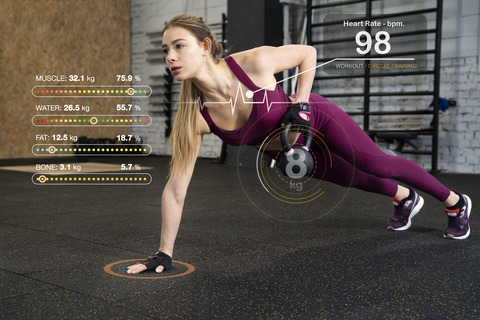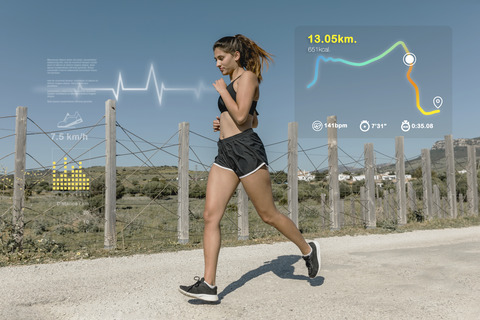In the quest for effective and sustainable fat loss, there’s a plethora of fitness and workout approaches to choose from. Among the myriad options available, high-intensity workouts have emerged as a potent tool to shed unwanted fat, sculpt your body, and supercharge your fitness journey. This article explores the world of high-intensity workouts, explaining what they are, why they’re effective, and how to incorporate them into your fitness routine to achieve remarkable fat loss results.
Understanding High-Intensity Workouts
High-intensity workouts, often abbreviated as HIIT (High-Intensity Interval Training), are a form of cardiovascular exercise that combines short, intense bursts of activity with periods of lower-intensity recovery or rest. The primary goal of HIIT is to elevate your heart rate rapidly, pushing your body to perform at its maximum capacity for short intervals. This is followed by recovery periods to allow your body to catch its breath before the next intense cycle begins.
The key components of a high-intensity workout include:
Intensity
High-intensity workouts are characterized by brief yet incredibly demanding segments of exercise. These segments push you to give it your all, elevating your heart rate and forcing your muscles to work at their peak performance levels. This high level of intensity is what differentiates HIIT from traditional steady-state cardio exercises.
Short Duration
HIIT sessions are relatively short, typically lasting anywhere from 10 to 30 minutes. The shorter duration is a practical advantage for those with busy schedules, but the effectiveness of the workouts is not compromised.
Alternating Intervals
High-intensity workouts follow a pattern of alternating between high-intensity intervals and recovery intervals. The duration and intensity of each interval can vary depending on the workout program. Common ratios include 1:1 (equal work-to-rest ratio) or 2:1 (double the time for work compared to rest).
Variety
HIIT workouts can be performed with a wide range of exercises, such as sprinting, cycling, jump roping, bodyweight exercises, and more. This versatility keeps your workouts engaging and helps prevent boredom, a common pitfall in fitness routines.
Adaptability
High-intensity workouts are adaptable to different fitness levels. Whether you’re a beginner, intermediate, or advanced athlete, you can tailor your HIIT workouts to match your current fitness capabilities.
Why High-Intensity Workouts Are Effective for Fat Loss
The popularity of high-intensity workouts is not merely a fitness trend; there is substantial scientific evidence supporting their effectiveness in achieving fat loss goals. Here are the primary reasons why high-intensity workouts are so powerful in this regard:
EPOC (Excess Post-Exercise Oxygen Consumption)
High-intensity workouts induce a state of Excess Post-Exercise Oxygen Consumption, commonly known as the afterburn effect. This means your body continues to burn calories even after you’ve finished your workout. The intense bursts of activity in HIIT sessions elevate your heart rate, and this increased heart rate persists even during the recovery periods. As a result, your body expends more energy for hours post-workout to recover and repair itself, which translates into more calories burned throughout the day.
Efficient Use of Time
One of the primary attractions of high-intensity workouts is their time efficiency. With sessions lasting as little as 10 minutes, you can achieve the same or even better fat-burning results as compared to longer, steady-state cardio workouts. This makes HIIT workouts especially appealing to those with busy schedules.
Preservation of Lean Muscle
High-intensity workouts are superior to traditional steady-state cardio in preserving lean muscle mass. During traditional cardio sessions, especially those that are longer in duration, your body may begin to break down muscle tissue for energy. In contrast, HIIT workouts focus on fat stores for energy, thereby helping you preserve and even build lean muscle mass. Lean muscle mass is metabolically active and contributes to a higher resting metabolic rate, meaning you’ll burn more calories even when you’re at rest.
Enhanced Fat Oxidation
HIIT enhances your body’s ability to oxidize or burn fat. The intense bursts of exercise stimulate enzymes that are crucial for fat metabolism. This means that your body becomes more efficient at using fat as a fuel source, which is essential for fat loss.
Improved Insulin Sensitivity
High-intensity workouts can improve insulin sensitivity, which is crucial for regulating blood sugar levels. Improved insulin sensitivity means that your body can more effectively utilize carbohydrates for energy and store them as glycogen, rather than as fat. This is particularly beneficial for fat loss as it helps prevent excessive fat storage.
Increased Metabolic Rate
High-intensity workouts elevate your metabolic rate, which is the rate at which your body burns calories at rest. This increase can persist for hours after a HIIT session, contributing to greater overall calorie expenditure and, consequently, fat loss.
Designing a High-Intensity Workout Routine
To effectively use high-intensity workouts to crush your fat loss goals, you’ll want to create a well-rounded workout routine. Here’s a step-by-step guide on how to do just that:
Establish Your Goals
Before diving into a high-intensity workout program, it’s essential to clarify your fat loss goals. Are you looking to shed a specific number of pounds, reduce body fat percentage, or achieve a certain level of fitness? Having clear goals will help you structure your workouts and measure your progress effectively.
Choose Your Exercises
One of the great advantages of high-intensity workouts is the variety of exercises you can incorporate. Select exercises that you enjoy and that align with your fitness goals. Common exercises for HIIT include:
Sprinting: Running sprints or using a stationary bike for short, intense intervals.
Bodyweight Exercises: Performing exercises like burpees, push-ups, or mountain climbers.
Jumping Exercises: Incorporating exercises such as box jumps or jump squats.
Resistance Training: Using weights or resistance bands for strength-based HIIT workouts.
Determine Work-to-Rest Ratios
The work-to-rest ratio is a critical aspect of HIIT workouts. The choice of ratio can affect the intensity and duration of your sessions. A 1:1 ratio (e.g., 30 seconds of work followed by 30 seconds of rest) is suitable for beginners, while a 2:1 or 3:1 ratio can increase the intensity for more advanced individuals. Experiment with different ratios to find what works best for you.
Create a Routine
Design a structured routine that includes both the high-intensity intervals and recovery periods. For instance, a 20-minute HIIT routine might consist of 10 rounds, each comprising 30 seconds of high-intensity exercise followed by 30 seconds of rest. Ensure that your routine is challenging but sustainable.
Warm-Up and Cool Down
Never skip your warm-up and cool-down. A proper warm-up prepares your body for the intensity ahead and reduces the risk of injury. Cool-down exercises help your body return to its resting state gradually and can aid in recovery.
Consistency Is Key
To see significant fat loss results with high-intensity workouts, consistency is essential. Aim for at least three to four sessions per week, but ensure your body has time to recover. Overtraining can lead to burnout and hinder progress.

Incorporating High-Intensity Workouts Into Your Routine
Now that you have a comprehensive understanding of high-intensity workouts and their benefits for fat loss, it’s time to explore how to seamlessly integrate them into your existing fitness routine. Here’s a step-by-step guide to help you get started:
Schedule Strategically
Begin by identifying the most suitable times for your high-intensity workouts. Consider your daily commitments, energy levels, and preferences. Some individuals prefer to start their day with a burst of high-intensity activity, while others find it more invigorating in the afternoon or evening. Choose a schedule that aligns with your lifestyle.
Balanced Approach
While high-intensity workouts are highly effective, it’s important not to rely on them exclusively. Incorporate a balanced fitness regimen that includes strength training, flexibility exercises, and some form of lower-intensity cardiovascular activity. This holistic approach will provide a well-rounded fitness foundation.
Listen to Your Body
Pay close attention to how your body responds to high-intensity workouts. It’s normal to feel fatigued, especially in the beginning. However, distinguish between regular post-exercise fatigue and signs of overtraining. If you experience excessive soreness, decreased performance, or prolonged fatigue, consider adjusting the intensity or frequency of your HIIT sessions.
Progressive Overload
To continue reaping the benefits of high-intensity workouts, it’s crucial to incorporate progressive overload. This involves gradually increasing the intensity or duration of your workouts as your fitness level improves. This can be achieved by increasing the number of intervals, adjusting work-to-rest ratios, or incorporating more challenging exercises.
Nutrition and Hydration
A balanced and nutritious diet is fundamental to support your high-intensity workouts. Ensure you’re consuming an adequate amount of carbohydrates, lean proteins, healthy fats, and plenty of fruits and vegetables. Proper hydration is also essential for optimal performance and recovery.
Recovery and Rest Days
Adequate rest and recovery are just as important as the workouts themselves. Allow your body the time it needs to repair and rebuild. This includes getting sufficient sleep, practicing active recovery (such as gentle stretching or light yoga), and taking scheduled rest days.
Monitor Progress
Track your progress to stay motivated and make necessary adjustments to your routine. Keep a workout journal, use fitness apps, or take measurements to monitor changes in your body composition, endurance, and strength.
Stay Consistent and Patient
Consistency is the cornerstone of any successful fitness regimen. Understand that fat loss is a gradual process that requires time, dedication, and persistence. Celebrate small victories along the way and trust the process.
Seek Professional Guidance
If you’re new to high-intensity workouts or have any underlying health concerns, consider seeking guidance from a certified fitness professional or healthcare provider. They can provide personalized advice and ensure you’re performing exercises safely and effectively.
Enjoy the Journey
Embrace the journey towards your fat loss goals. Remember that fitness is not solely about aesthetics; it’s about improving your overall health and well-being. Find joy in the progress you make, and revel in the newfound energy and confidence that comes with prioritizing your health.
Incorporating high-intensity workouts into your fitness routine can be a game-changer in your fat loss journey. With careful planning, consistent effort, and a balanced approach, you’ll be well on your way to achieving the results you desire. Remember, your fitness journey is unique to you, so trust your instincts, listen to your body, and enjoy the transformational process. Here’s to a healthier, fitter, and more vibrant you!

